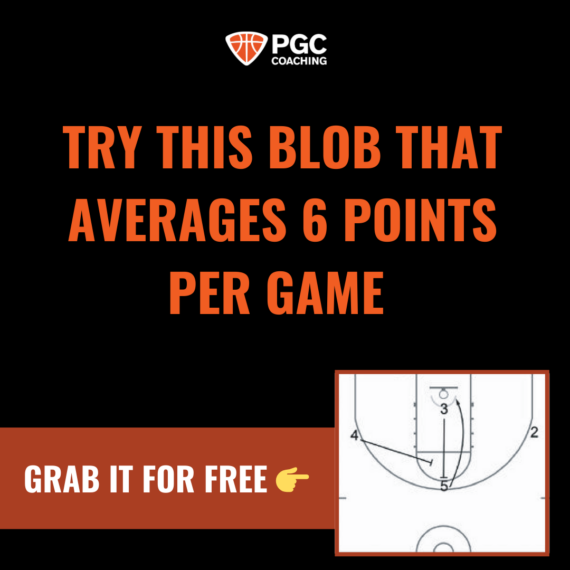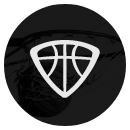5 Must-Have Defensive Drills for High-Energy, Game-Ready Teams
At PGC, we believe defense isn’t just a skill—it’s a standard. And if you want to win in March, you’d better start building habits in June.
So here’s your all-in-one guide to five of our most effective basketball defense drills, all designed to instill game-ready habits, elevate basketball IQ, and foster a relentless team identity.
Before we get into the basketball defensive drills, I want to make sure you have a few more resources at your fingertips. So while we’re on the subject, here are a few more resources you may be interested in:
- How to Teach On-Ball Defense That Actually Works in Games
- How to Train Help Defenders to Win 2-on-1 Situation
- Jump. Mud. Bubble. The 3 Habits Your Defense Is Missing
Okay, so let’s dive in.
1. Closeout Assignments Basketball Defense Drill
Build discipline and awareness with purpose-driven closeouts.
This drill helps players close out differently depending on who they’re guarding—a shooter, a non-shooter, or a complete player. It’s all about situational awareness, footwork, and energy.
What you’ll teach:
- How to disrupt rhythm shooters
- How to contain dangerous drivers
- When to give space and when to take it away
Watch the Closeout Assignments Basketball Defense Drill
2. On-Ball Basketball Defense Habits
Train defenders to control space and keep their nose in front of the ball.
Players learn to stick, bounce, and maintain a reactionary gap—all while staying low and active.
What you’ll teach:
- Active hand placement (“stick hand”)
- Reaction timing (“bounce”)
- How to guard your yard
Watch the On-Ball Basketball Defense Habits Drill
3. Mud, Jump, and Bubble Basketball Defense Drill
Create defensive habits through accountability and language.
This “culture drill” teaches terms like “mud,” “jump,” and “bubble,” helping players lock into responsibilities and communicate effectively—even from the sidelines.
What you’ll teach:
- Jump-to-the-ball reactions
- Ball pressure with “bubble”
- Verbal accountability and feedback
Watch the Mud, Jump, and Bubble Basketball Defense Drill
4. 2-on-1 Bear Basketball Defense Drill
Develop help defenders who can fix broken plays and turn stops into steals.
This drill teaches players to “protect the den” by reading space, buying time, and making smart decisions in defensive disadvantages.
What you’ll teach:
- Game-saving help-side instincts
- How to disrupt numbers disadvantages
- What a defensive “win” looks like on a 2-on-1
Watch the 2-on-1 Bear Basketball Defense Drill
5. Post 4D Basketball Defense Drill
Train post defenders to stay active and anticipate four key actions.
This drill develops awareness in guarding the catch, bounce, flash, and drawing charges—helping bigs defend smartly and cleanly.
What you’ll teach:
- How to wall up without fouling
- Timing for rotating on flash cuts
- Taking charges as a form of leadership
Watch the Post 4D Basketball Defense Drill
FAQ: Basketball Defense Drills That Build Game-Ready Habits and Relentless Teams
These FAQs dive deeper into how to implement and teach the basketball defense drills featured in the blog. They’re designed to help you improve communication, habits, and effort across your entire defensive system.
Q: What makes a great basketball closeout?
A: A great closeout adjusts based on who you’re guarding. The Closeout Assignments Drill teaches players how to read offensive skill sets and adjust:
- High hand closeouts vs. shooters
- Cushion space vs. drivers
- Balanced stance vs. all-around threats
This situational approach builds smarter, more adaptable defenders.
Run the Closeout Assignments Drill to teach purposeful, disruptive closeouts.
Q: How do I teach consistent on-ball defense habits?
A: The key is repetition and language. The On-Ball Defense Habits Drill breaks it down into:
- “Stick” for active hands
- “Bounce” for timing and balance
- “Guard your yard” for containment
These cues give players anchors they can rely on in game situations, helping them stay low, active, and in control.
Use this drill daily to instill consistent, coachable defensive habits.
Q: What is the purpose of using defensive cue words like ‘mud’ and ‘bubble’?
A: Cues like “mud,” “jump,” and “bubble” create a shared language and raise accountability. The Mud, Jump, and Bubble Drill turns these terms into habits:
- “Jump” = rotate on the pass
- “Bubble” = ball pressure positioning
- “Mud” = help defense responsibilities
It’s a culture-building drill that improves execution and communication.
Incorporate verbal cues into every defensive drill to build accountability and clarity.
Q: How can I teach help defenders to cover breakdowns in real time?
A: Use the 2-on-1 Bear Drill to simulate defensive disadvantages. The defender learns to:
- Delay the ball for help to arrive
- Use angles to disrupt passes
- Recover without fouling
This builds fast instincts and mental toughness in help-side scenarios.
Run this drill weekly to build smarter help defenders who thrive under pressure.
Q: How do I train post defenders to react without fouling?
A: Post defense is about movement and anticipation—not just strength. The Post 4D Drill teaches four reaction types:
- Guarding the catch
- Reacting to the bounce
- Rotating on the flash
- Taking charges
These reps build both IQ and physical presence in the post.
Use Post 4D to give your bigs the reps they need to defend smartly and cleanly.
Q: Can these drills help with team communication?
A: Yes. Most of these drills embed communication as a core requirement. In Mud, Jump, and Bubble, even the sideline players are coached to give feedback. Building a talking defense starts with integrating verbal accountability into every rep. Communication becomes a standard when it’s practiced daily.
Designate one drill per practice that focuses specifically on defensive communication.
Q: How do I adjust these drills for youth or beginner teams?
A: Focus on simplified reads and execution. For younger players:
- Shorten space in 2-on-1 Bear
- Limit reads in Post 4D
- Run On-Ball Habits at half-speed
Gradual layering of complexity helps players build confidence and execution.
Adapt drill intensity to match your team’s age and experience level.
Q: How often should I use defense-only drills during the season?
A: Defensive habits must be reinforced regularly. You don’t need full-length defensive sessions daily, but 10–15 minutes per practice using drills like Closeout Assignments or On-Ball Habits can make a huge difference. These focused segments keep energy high and defense top-of-mind. Small, consistent doses often produce better retention than long, infrequent sessions.
Integrate one focused defensive drill into each practice block.
Q: How do I measure improvement in team defense using these drills?
A: Use metrics like:
- Closeouts without fouling
- Stops or turnovers from 2-on-1
- Verbal cue usage
- On-ball containment time
These indicators help you assess growth beyond just in-game stats.
Chart simple metrics for each drill to track player development and team growth.
Final Thoughts
These drills aren’t just about individual improvement—they’re about building a team identity. A team that communicates, rotates, contests, and never takes a possession off.
If you want your defense to travel, it starts with training like this—intentionally, repeatedly, and together.
Want more drills like this? Get instant FREE access to every drill, strategy, and tactic we’ve ever published with a 7-day trial of our PGC Coaching Community.
TJ
Check out all of our offensive drills and strategy resources here.
About the Author
TJ Rosene
Coach TJ Rosene, head coach of the Emmanuel University men’s basketball team and Director of Coach Development for PGC Coaching, has spent his career shaping young athletes both on and off the court. With over 400 career wins and 12 seasons of 20+ wins, Rosene’s coaching experience is extensive and impressive. His teams have competed in six national championship games, winning three NCCAA National Championships. Under his leadership, the Lions made their NCAA Division II debut in 2018-19 and quickly captured two season titles and one tournament title, along with an appearance in the NCAA Division II Sweet 16 in 2021.
Rosene’s success expands far beyond the scoreboard. He’s been named National Coach of the Year three times and Conference Carolinas Coach of the Year twice. But for Coach Rosene, the most meaningful part of his work is the lasting impact he has on his players’ lives. As he puts it, “Coaching is a rare opportunity to shape and mold the lives of young people. It’s a privilege that I never take for granted.”
New Here?
Get coaching tips and tools like these delivered to your inbox each week!
Join the 15,000 coaches we’ve assisted…

Related Articles
5 Passing Drills to Build Tough, Smart, & Unselfish Basketball Players
Want fewer turnovers and sharper ball movement? These 5 game-ready passing drills will help your players handle pressure, make better reads, and move the ball like a team built to win.
4-on-4 Finishing Game: Train Shot Selection, Spacing & Competitive Intensity
Boost your team’s finishing skills with our 4-on-4 drill! Build shot discipline, smart decisions, and strong finishes under real-game pressure. Perfect for game-ready players.
Comfort in Chaos: Train Game-Ready Finishing Under Pressure
Help your players finish strong in chaos. The Comfort in Chaos drill builds confidence and composure under pressure for game-ready scoring.
About PGC
PGC Basketball provides intense, no-nonsense basketball training for players and coaches. Our basketball camps are designed to teach players of all positions to play smart basketball, be coaches on the court, and be leaders in practices, games and in everyday life.
We combine our unique PGC culture with a variety of teaching methods and learning environments to maximize the learning potential of those that attend our sessions. In addition to spending 6-7 hours on the court each day, lessons will be reinforced through classroom sessions and video analysis.
Our goal at PGC is to empower you with the tools to fulfill your basketball dreams, while also assisting you in experiencing the joy of the journey.
To learn more about PGC Basketball, including additional basketball training tips and videos, visit our YouTube Channel or find us on Facebook, Instagram, and Twitter.





Share This Post